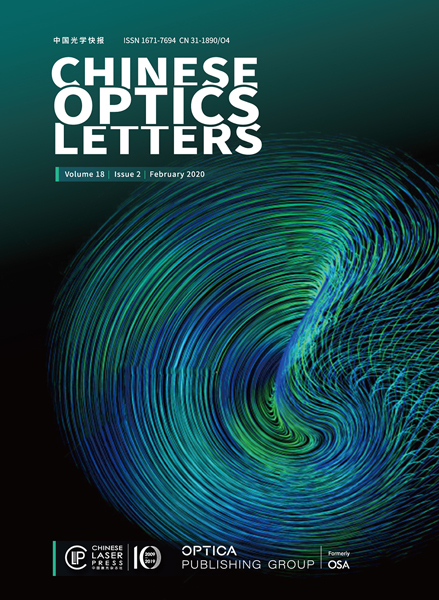 View fulltext
View fulltext
Integrated diffractive optical mode converter, consisting of a diffractive optical element (DOE) and a slab waveguide, is used for fiber-to-waveguide coupling. The phase of the DOE is generally designed by optimization algorithm. In this paper, the precise design, a new method with one more restrictive way, is adopted to design the diffractive optical mode converter for fiber-to-waveguide coupling. Through this method, the intensity of any point on the output plane is fully filled with the required demand. Compared with what previously published, the coupling loss of the precise designed converter is lower.
We present a modified method to design photonic crystal fibers (PCFs) with flattened dispersion characteristic. Using this modified PCF we design a broadband fiber optical parametric amplifier (FOPA), which provides a gain of 8 dB with 1.5-dB uniformity over a 260-nm bandwidth. Both the simulation results of total dispersion of PCF and the gain spectrum of FOPA are demonstrated.
A strain-induced birefringence double-clad (DC) fiber Bragg grating (FBG) is proposed and demonstrated. The grating is fabricated in the core of rectangular inner cladding double clad fiber by using phase mask method. By applying lateral strain on the grating, the birefringence is induced. In order to detect the birefringent effect of the grating, we use it as the output mirror of a laser. When lateral strain is applied, the grating becomes birefringent. Therefore, one reflection peak of double-clad fiber Bragg grating becomes two peaks and the laser also lases in two wavelengths. The wavelength spacing of the laser can be tuned from 0 to 0.8 nm. The absolute wavelengths for the two polarizations can be tuned 1.2 and 2.0 nm, respectively.
We studied the transmission performance of metro networks employing cascaded thin-film filters (TFFs) for three modulation formats including non-return-to-zero (NRZ), duobinary, and carrier-suppressed RZ (CSRZ). The effects caused by TFFs' dispersion and passband characteristics are investigated for 10- and 40-Gb/s signals, respectively. Simulation results show that the penalty resulted from dispersion can be partially compensated by the passband effects of the cascaded filters. CSRZ is shown to be a preferred format compared with NRZ and duobinary primarily originating from its good back-to-back performance.
A new image registration algorithm with robust cost function and progressive refinement estimation is developed on the basis of direct method (DM). The robustness lies in M-estimation to avert larger local noise and outliers. Moreover, the progressive refinement model estimation under the multi-resolution framework, where the initial parameter values of coarse level are estimated by Mellin transformation, is adopted so as to get global optimization and reduce search space. Experiments show that the proposed algorithm greatly extends the scope of the conventional DM of image registration.
SiO2/TiO2/methylcellulose composite materials processed by the sol-gel technique were studied for optical waveguide applications. With the help of methylcellulose, an organic binder, SiO2/TiO2/methylcellulose hybrid thick films were prepared by a single spin-coating processes. After annealing at 70 Celsius degree for an hour, 2.5-μm crack-free and dense organic--inorganic hybrid optical films with a refractive index of 1.537 were achieved. Optical losses of plane waveguide made up of those films and ordinary slide glass substrate are around 0.3 dB/cm at 650 nm. Scanning electronmicroscopy (SEM) and UV-visible spectroscopy (UV-VIS), have been used to characterize the thick films.
Using both acoustic-optic (AO) Q-switch and GaAs saturable absorber, a diode-pumped doubly Q-switched Nd:GdVO4/KTP green laser is realized. This laser can generate a shorter and more symmetric pulse in comparison with purely AO and passively Q-switched lasers. In the meantime, the rate equations describing the operation of a diode-pumped, AO and GaAs doubly Q-switched Nd:GdVO4/KTP green laser are introduced. These equations are solved numerically and the dependence of pulse width on incident pump power is obtained. The numerical solutions are in agreement with the experimental results.
A 47-wavelength flat erbium-doped fiber ring laser over whole C-band is experimentally achieved with only 21-dBm output power from erbium-doped fiber amplifier (EDFA). The spectrum flatness of the multi-wavelength erbium-doped fiber laser (EDFL) is investigated.
A polarization modulator based on splitting with a Savart plate and rotation of an analyzer for a moire system with grating imaging is presented, and its modulation principle is analyzed. The polarization modulator is simple and achromatic. It is composed of a polarizer, a Savart plate, and an analyzer. The polarizer and the Savart plate are placed in front of the index grating to split the image of the scale grating in the moire system. The analyzer is placed behind the grating and rotated to realize the modulation of the moire signal. The analyzer can be rotated either continually with high speed or step by step with low speed to form different modulation modes. The polarization modulator makes the moire system insensitive to the change of initial intensity. In experiments, we verified the usefulness of the polarization modulator.
In this paper, a depth-graded C/W multilayer mirror with broad grazing incident angular range, consisting of three multilayer stacks, each of which has different period thickness d and the layer pair number, was designed and fabricated by direct current (DC) magnetron sputtering. For calculating the definite performance of such a mirror, the saturation effects of the interfacial imperfection, such as interface roughness and diffusion, were emerged. The reflectivity of the mirror was measured by the X-ray diffraction (XRD) instrument at Cu Kα radiation (λ = 0.154 nm), the measured reflectivity was about 30% in a broad grazing incident angular range (0.55---0.85 deg.). By the fitting data, the thickness of each layer is almost same as the one designed and the roughness in the multilayer is about 0.85 nm, which is larger than the prospective value of 0.5 nm.
Ultra-short-period W/C multilayers having periodic thickness range of 1.15---3.01 nm have been fabricated for soft X-ray optics using the high vacuum direct current (DC) magnetron sputtering system. These multilayers were characterized by low-angle X-ray diffraction (LAXRD) and transmission electron microscope (TEM). The results show that the multilayer thin films with periodic thickness more than 1.5 nm have clear W-C interface and low roughness. But the structure of the periodic thickness below 1.5 nm is not clear. Finally, three ways to improve the performance of the multilayers are suggested.
The optical absorption edge and ultraviolet (UV) emission energy of ZnO films deposited by direct current (DC) reactive magnetron sputtering at room temperature have been investigated. With the oxygen ratio increasing, the structure of films changes from zinc and zinc oxide coexisting phase to single-phase ZnO and finally to the highly (002) orientation. Both the grain size and the stress of ZnO film vary with the oxygen partial pressure. Upon increasing the oxygen partial pressure in the growing ambient, the visible emission in the room-temperature photoluminescence spectra was suppressed without sacrificing the band-edge emission intensity in the ultraviolet region. The peaks of photoluminescence spectra were located at 3.06---3.15 eV. From optical transmittance spectra of ZnO films, the optical band gap edge was observed to shift towards shorter wavelength with the increase of oxygen partial pressure.
The evolution characteristics of quantum state fidelity in an interacting system of single-mode light field and atomic Bose-Einstein condensate have been studied and the influence of the initial light field intensity and the interaction among atoms of Bose-Einstein condensate on the quantum state fidelity respectively have been discussed.
For a weakly and periodically driven two-component Bose-Einstein condensate (BEC) the Melnikov chaotic solution and boundedness conditions are derived from a direct perturbation theory that leads to the chaotic regions in the parameter space. Differing from the usual results, the chaotic regions depend on the initial conditions directly and can be controlled by setting the initial phase and modulating the frequency and amplitude of laser. It is demonstrated that the order-chaos transitions can be controlled by tuning the laser frequency only.
We present a semimonolithic frequency-doubler from 1080 to 540 nm with 80% doubling efficiency and up to 849-mW output power of green light. A frequency-stabilized laser diode (LD) pumped continuous wave (CW) Nd:YAP laser is used as the pump source of the doubler consisting of an α-cut KTP crystal and an input mirror. The frequency stabilities of the output second harmonic wave are better than +/-246 kHz and +/-2.3 MHz in 1 and 30 minutes, respectively, and the intensity fluctuation is less than +/-0.65%.
The operational procedures for efficiently reconstructing the two-dimensional image of a body by the filtered back projection are described in this paper. The projections are interpolated for four times of original projection by zero-padding the original projection in frequency-domain and then inverse fast Fourier transform (FFT) is taken to improve accuracy. Nearest interpolation is applied to decrease operation time. Projection dependence of next pixel at the same row is used. For each row of image, the first pixel projection once for each angle is pre-computed, other pixel projection of this row can be found by iteration. Therefore, the pre-interpolation process only has to be performed once for each row, rather than individually for each pixel. It greatly reduces the amount of computation. Compared with original implementation, the speed of reconstruction image is nearly improved by five times. The image accuracy is still preserved.
The spectral behavior of polychromatic spatially fully coherent light diffracted by an annular aperture in the far field is studied. It is shown that the spectrum in the far field is generally different from that at the aperture, i.e., the spectrum in the far field is proportional to the spectrum at the aperture and a spectral modifier, which depends on the central obstruction ratio ε and diffraction angle θ. Detailed numerical calculation results indicate that significant spectral changes take place in the vicinity of zeros of the Airy pattern. It is found that at the critical diffraction angle θc, the spectrum is split into two lines, while at a diffraction angle a little smaller than θc, the spectrum is red-shifted, and at a diffraction angle a little larger than θc, the spectrum is blue-shifted. The influence of the central obstruction ratio on the spectral anomalies is presented.
For space optical remote sensor (SORS) with either film or time delay and integrate charge coupled device (TDI-CCD) imaging, in order to achieve higher resolution it requires more accurate real-time image motion compensation. This primarily depends on real-time computation of the image motion velocity vector (IMVV) and error budget and synthesis on related parameters. An effective modeling scheme is introduced and the derivation of IMVV equation, error budget and synthesis by Monte-Carlo method are presented in detail. This total solution was applied to SORS system test on orbit and has been confirmed to be very accurate based on the resolution, transfer function at Nyquist frequency, signal-to-noise ratio and average gray scale of the captured images.
The equi-luminance of color stimulus in normal subjects is characterized by L-cone and M-cone activation in retina. For the protanopes and deuternopes, only the activations of one relevant remaining cone type should be considered. The equi-luminance turning curve was established for the recorded visual evoked potentials (VEPs) of the luminance changes of the red and green color stimulus, and the position of the equi-luminance was used to define the kind and degree of color vision deficiencies. In the test of 47 volunteers we got the VEP traces and the equi-luminance turning curves, which was in accordance with the judgment by the pseudoisochromatic plate used in clinic. The method fulfills the objective and quantitative requirements in color vision deficiencies test.










